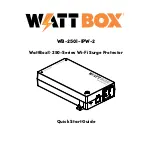
INSTALLATION & SETUP
VistaPro 2000 User's Manual
2-2
Make Necessary Display Adjustments
With the input image displayed, rotate the lens barrel to increase or decrease
image size (applies to zoom lenses only). Then rotate the nearby Vertical Offset
knob to achieve the best overall image position and brightness without a
distortion in picture geometry. Next, rotate the focus adjustment knob (next to
the lens barrel) to achieve best focus. Press
to refine other display
adjustments, press
if you want to select a different source. See 3.5, Using
Sources.
Although VistaPro 2000 delivers a high brightness quality output, the final
display quality could be compromised if the projector is not properly installed.
This subsection discusses issues you should consider before proceeding with a
final installation. Even if you do not intend to use VistaPro 2000 in a fixed and
permanent installation, this subsection will help you to better understand what
may be done to enhance display performance.
Choose the installation type which suits your needs: front or rear screen, floor
mount or inverted mount.
Front Screen, Floor Mount Installation
ADVANTAGES
CONSIDERATIONS
•
Easy to set up
•
Can be moved or changed quickly
•
Easy to access
•
Shares floor space with audience
Front Screen, Inverted Mount (ceiling) Installation
ADVANTAGES
CONSIDERATIONS
•
Does not take up audience space
•
Projector is unobtrusive
•
Projector cannot be accidentally moved
•
Installation is more permanent
•
It is more difficult to access the projector
Rear Screen, Floor Mount Installation
ADVANTAGES
CONSIDERATIONS
•
Projector is completely hidden
•
Projector is easily accessed
•
Usually good ambient light rejection
•
Requires separate room
Rear Screen, Inverted Mount (ceiling) Installation
ADVANTAGES
CONSIDERATIONS
•
Projector is completely hidden
•
Usually good ambient light rejection
•
Requires separate room
•
Installation cost is usually higher
Rear Screen, Floor Mount with Mirror
ADVANTAGES
CONSIDERATIONS
•
Projector is completely hidden
•
Usually good ambient light rejection
•
Requires less space behind screen than
other rear screen installations
•
Requires separate room.
•
Installation cost is usually higher
Screen type is important when designing a projection system. Inexperienced
users or installers should always consult their dealer when deciding on screen
type. The following guidelines explain the differences between screen types.
STEP 6
'
2.2
Installation
Considerations
Installation Type
'
Screen Type
'






































